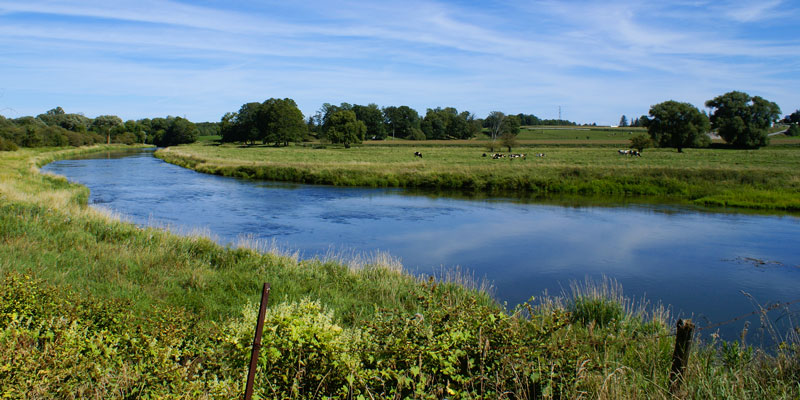A Regional Monitoring Framework for Supporting Cumulative Effects Assessment and Adaptive Management in the Grand River
Dr. Mark Servos, Research Chair, Water Quality Protection, Department of Biology, University of Waterlo (2012-2014)

Challenge
The Grand River watershed is located in southwestern Ontario and is threatened by multiple stressors from sources like municipal and industrial wastewater discharges, agricultural activities, urban development and atmospheric deposition. The nature and number of stressors makes monitoring, assessment and management of the watershed difficult, and there are multiple municipalities, regulators and industries operating within the watershed. To address these complex issues, a scientific team led by Dr. Servos is conducting research that will inform the development of an integrated watershed-level monitoring framework for the Grand River watershed.
The project addresses three key needs of the Grand River Watershed Consortium:
1) To synthesize historic and current biomonitoring research and studies in the Grand River watershed and develop a monitoring approach to identify biological indicators to detect change from stressors throughout the watershed
2) To improve scientific understanding of the relationship among biological, physical and chemical processes in the river
3) To develop a regional biomonitoring framework to predict changes in the watershed
Project
The physical, chemical and biological characteristics of rivers are complex and highly variable across the length of the watershed, and change dramatically over time. Numerous studies have examined the factors that alter ecosystems and communities across the river continuum and the influence of factors such as flow, connectivity and habitat diversity. Not surprisingly, detecting change in ecosystems and communities is a very difficult task that requires considerable understanding of natural and human stressor-induced variability in the system. This study tested the predictive relationships among the biological, physical, and chemical processes in the river to strengthen interpretation of biotic indicators that respond to changes or stressors within the watershed.
The objectives of the Grand River Watershed Consortium involved the development and implementation of an integrated watershed monitoring framework. The project provides the Consortium with fundamental information across three main areas. This project synthesized historic and current biomonitoring research and studies in the Grand River watershed, including available data on water quality, productivity and organism distribution and abundance within the Grand River. A research/monitoring approach was developed to determine biotic indicators that can detect change from stressors across the watershed, from its headwaters to the lower river regions. The researchers seek to improve the understanding of the relationships among biological, chemical and physical processes to develop tools to describe how biotic indicators respond to changes and stressors in the watershed.
Outputs
This research project held several key end-user oriented meetings:
- Joint Researcher/Consortium Meeting, Grand River Conservation Authority
- Creation of a dialogue between researchers and end users, University of Waterloo
- Grand River CEA Researchers Review and Planning Meeting (Consortium representatives invited to participate)
- CWN inter-node meeting, Saint John, NB
- Meeting with the Region of Waterloo to present research progress
- Cumulative Impacts of Headwater Streams Working Group, Ontario Ministry of Natural Resources/Toronto and Region Conservation Authority
The results have also been disseminated through several presentations.
- Servos et al. Assessing the environmental risk of emerging contaminants in municipal wastewater. Canadian Water Network, Ottawa, ON
- Servos, M. Wastewater watersheds and the War of 1812: win, lose or tie? The 5th Canadian Wastewater Management Conference Hamilton, ON
- Tetreault et al. One fish, two fish, boy fish or girl fish? Does feminization of male fish lead to community level impacts? SETAC Laurentian Chapter Seminar Series, Burlington, ON
- Servos, M. The effects of wastewater on fish populations. Water Institute Annual Meeting, Waterloo, ON
- Servos, M. Fish responses to wastewater in the Grand River. Institute for the Environment, University of Brunel, Uxbridge, England.
- Servos et al. Effects of wastewater effluents in the Grand River, Ontario, on the reproductive function of fish. American Water Resources Association. Denver, Colorado
Scholarly journal articles:
- Tetreault et al. 2013. Fish community responses to multiple municipal wastewater inputs in a watershed. Integrated Environmental Assessment Management On line, http://dx.doi.org/ 10.1002/ieam.1364
- Tanna et al. 2013. Occurrence and degree of intersex (testis-ova) across an urban gradient in the Grand River, Ontario, Canada. Environ. Toxicol. Chem. On line, http://dx.doi.org/10.1002/etc.2262
Outcomes
- Improved understanding of the relationships between biological, chemical and physical processes within the Grand River to design more effective tools to measure and predict biological change in the watershed.
- Changes in practice upon identification of early indicators of change associated with key stressors and their cumulative effects so that the Grand River Watershed Consortium can adaptively manage the river and enhance and protect its valued ecosystem components and services.
- Contributions to the future creation of a framework to integrate and interpret environmental monitoring data that will allow long-term assessment of the success of policy and management actions taken across the watershed.
- A strong scientific rationale for supporting water managers to implement bioassessments to help monitor progress toward goals stated in the Grand River Water Plan.





